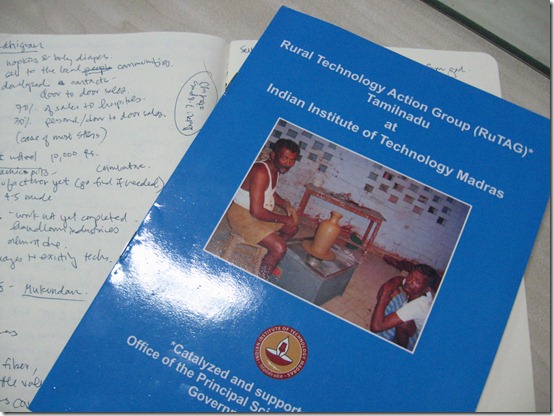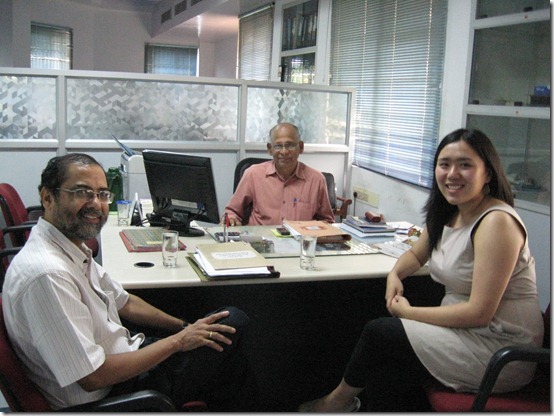Prashanth dropped me off at IIT Madras once again. I wandered around on campus and took the shortcut to the little student area where you can buy toiletries and small snacks. I hung out there for awhile and made a phone call to Nishant of Desta, which is a rural retailer in India. Their model is similar to Villgro Stores, in the sense that they have a retail presence and use micro-level entrepreneurs to extend products into rural areas through marketing and sales. The stores act as a warehouse that is closer to the people. The hardest part of any model that uses village level entrepreneurs, though, is finding good entrepreneurs. Nishant says that working through existing stores does make sense, since the kirana wallas know business. However, there’s definitely another side of the story to that as well, especially if you talk with other people who have tried it. Everything has trade offs.
Professor Jalihal was running late, so I met with Mr. Gopalakrishnan in RuTAG’s office. We went down a list, technology by technology, to discuss the current status of RuTAG inventions and their appropriateness for Essmart. Since Essmart is going to be surveying in Pollachi, Mr. Gopalakrishnan thought the coir ratt would be a good idea. Pollachi has a lot of coconuts, and the coconut fiber is shipped to nearby Kerala for processing. The coir ratt would keep this activity in Pollachi, thus increasing incomes in the area. It costs Rs 20,000 to 22,000 to manufacture, though – it’s a high cost product, yes – and thus it probably require a different distribution channel. I believe that Prashanth and I will include it on our updated survey, though, and we will be giving the survey to agricultural outlets, too.
Mr. Gopalakrishnan also shared that a NGO has contacted him regarding the design of a solar fan. No one in India has been able to get the price down low enough, so he’s looking for designers elsewhere. I’m not sure who comes across this blog, but why not advertise it here? He needs someone to design a fan that costs, at maximum, Rs 5,000 (about $100). Ideally, it would be a 30 watt fan with a 35-40 watt solar panel.
In the middle of my day, Prashanth called with news about hiring students from a university in Pollachi to help us with our surveys. We’re offering a significant stipend for high-quality data gathering in the villages around Pollachi. With their help, we’ll be able to get information from around 200 stores. This data will help us 1) understand the current retail situation in and around Pollachi and 2) gauge interest in the types of products that store owners would be interested in selling. I’m excited about the results!
Later that evening (post-Sparky’s, which will be discussed in another post), Prashanth and I began talking about whether or not to do an inventory experiment. Since we were having difficulty getting products on time, we were going to postpone the experiment. However, I believe that we can get three products, and I’d like the experiment to go on. The plan is to find a store and ask that store to stock 3-5 units of each product. We would train the store owner about the products. Over the course of one month, a local MBA student will check in on the store regarding interest about the products. The student will keep track of their sales. At the end of one month, the store owner will be paid 10 percent of the value of the products as his commission. The point is to see if these type of social impact products can sell from stores if the store owner is trained. Prashanth isn’t too sure that a community demonstration would work in a larger area like Pollachi. I think it would be interesting to do two experiments: one in Pollachi, and one in a town of about 5,000 to 7,000 people. That experiment would just be with virtual inventory, though, not physical inventory that is kept in stock at the store. Additionally, we would do a legitimate community demonstration.



Follow Us!